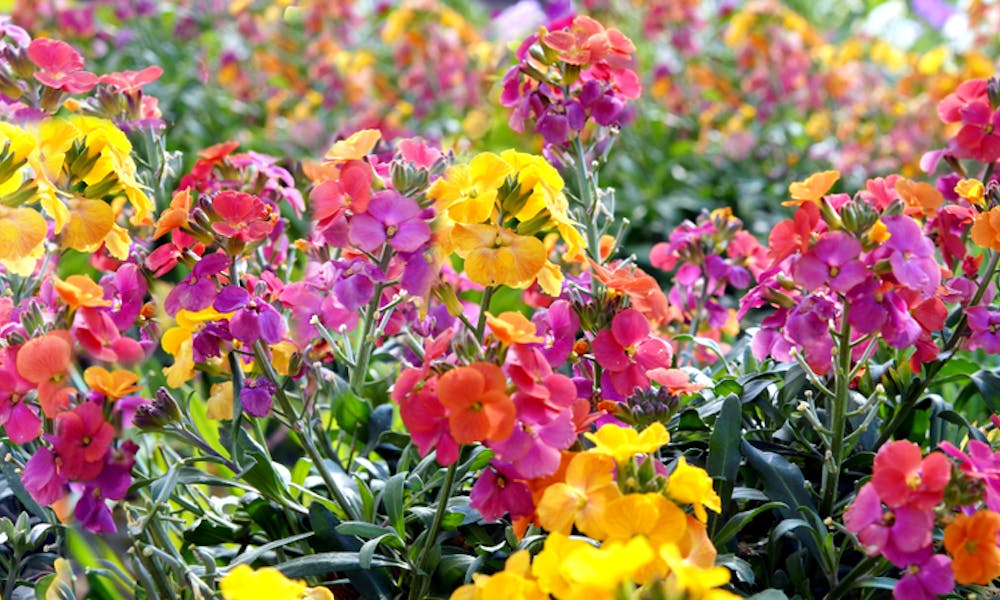MENU
The Wallflower Should Make a Comeback in Gardens

We are sure you have heard of the term to describe someone as a “wallflower,” which is to be explained. However, today we are talking more about the shrub itself. The low mound of a wallflower bush has bright green foliage, covered with fragrant flowers in the spring. Commonly seen growing on walls or cliffs, the bush doesn’t grow too big to handle and is often seen in gardens. The wallflower is seen in the wild as well since the seed pods form and open on their own, spreading the seeds. Though only having a life-cycle of two years, the fragrance and beauty of the wallflower is not to be overlooked. Learn about the three most common varieties below as well as growing your own wallflower bush from seed.
Today, in this article, we are going to learn more about the Wallflower, including the following:
* Taxonomic Hierarchy of the Wallflower
* Anatomy of a Wallflower
* Wallflower Varieties
* Starting Your Own Wallflower Bush
* Pests and Diseases
* The Idiom Behind the Wallflower
* Taxonomic Hierarchy of the Wallflower
Taxonomy of the Wallflower
The taxonomic rank is a hierarchy of biological groups to categorize various organisms. Within the main groups, there are subsumes to classify and describe the organisms more specifically. The main ranks, in order, are: Life, Domain, Kingdom, Division, Class, Order, Family, and Genus. In the rank, Kingdom, the wallflower falls under the subsume, Plantae. Following that, is Division, which is also known as Phylum. The subsume for Division is Magnoliophyta. After Division comes Class, where the wallflower falls under the subsume Magnoliopsida. The Order is next, where the wallflower is described under the Brassicales subsume. The last rank, Genus, contains a subsume Erysimum, which is used to describe the wallflower.
Anatomy of a Wallflower
While the subshrub is covered with clusters of blooms generally beginning in the month of April, the flowers themselves are quite small, not exceeding two inches. Orange or yellow flowers are the colors most commonly seen, though, red and shades of purple are also available. Each bloom consists of four petals and four sepals, which surround the petals before it opens up, showing off its beauty. They then turn to seed pods, which are valuable to keep and sow when the time is right. Given the four petals of each flower, it resembles the shape of an ‘X’ or some people would say the letter ‘H.’ With the pistal in the center, there are six stamen, four of which are tall, and two are short. The vertical branching stems are capable of reaching a height up to 3 feet, but no shorter than half of a foot.
Wallflower Varieties
The wallflower, also known as the Cheiranthus Flower, is actually considered a wildflower. Belonging in the mustard family, it is occasionally placed in the Erysimum genus. Out of the 375 genera, only 55 are currently found in Northern America. There are three varieties that are the most common.
Read about each variety below:
Cheiranthus Kewensis:
* Known as the English wallflower.
* Consists of dark red, yellow, orange, or purple colored flowers. The hybrids however, start off a burnt orange color and change to a purple tinge.
* This variety is often seen in flower beds in European countries during the spring.
Cheiranthus Allionii:
* Known as the Siberian wallflower.
* Blooming profusely in April or May, the flowers are orange or yellow.
* This variety is hardier than the Cheiranthus Kewensis because it is sometimes considered a product of Erysimum asperum, which is a native American species.
Erysimum Linifolius:
* Known as the alpine wallflower.
* Produces small lilac flowers.
* Is often used in rock gardens.
Starting Your Own Wallflower Bush
Keep in mind, plants grown from seed only produce foliage in the first year, but the second year provides you with an abundance of flowers. Since the seed pods readily grow after the blossoms die, it’s easy to seed your own wallflower bush. Wait until the seedpods have turned slightly white and the seeds within the pod should be brown. From May to July (depending on the weather, of course) is the best time to sow your seeds. Add a layer of compost to your sandy, well-drained soil ensuring your area is weed free. Sow a thin, even layer of seed on top. Do not cover the seeds as light assists with germination. Water them well and wait until they are two to three inches tall before separating or thinning your seedlings. Plant each seedling nine inches apart in a sunny location.
The Idiom Behind the Wallflower
An idiom is a phrase or figure of speech having a figurative meaning, which isn’t deducible from the individual words themselves. A wallflower is someone who remains in the background of social events or those left on the sideline of an activity. Since the wallflower grows clinging onto rocks and walls, and tends to stay on the sidelines, the idiom wallflower was born. Though it is used to describe such a person who was metaphorically clinging to a wall as opposed to taking part in the activity or event and seems unpopular, the Wallflower is making a comeback and deserves to be recognized as it’s a great plant to pot, plant in the ground or use for cutting in arrangements.
The wallflower easily produces seed pods after the blooms have spent and is easy to start from seed. The shrub is also easy to transplant and has an effortless maintenance regime. The fragrant spikes of flowers are worth the wait if growing from seed and grows as a perennial in warmer climates where you can enjoy their beauty and fragrance year after year. Since the wallflower is grown in the cracks of walls and cliffs, they prefer a sandy, alkaline soil that is well-drained, in a sunny location. This also makes sense as to why they are drought tolerant.

